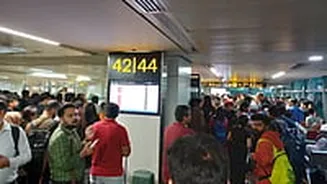The Initial Outage
On a recent day, Delhi's Indira Gandhi International Airport found itself grappling with a significant technological failure. This disruption brought with it considerable
challenges, as the airport experienced an extensive operational halt. The initial impact of the tech glitch was swiftly felt throughout the airport's various functions. Flights were delayed, and the normal flow of passengers was seriously impacted. Furthermore, the situation underscored the critical importance of a stable and fully functional tech infrastructure within any modern airport environment. As the airport staff and technical teams began their assessments, it became apparent that the problem was multifaceted, requiring a thorough investigation to identify the root cause.
Impact on Operations
The technological issue at the Delhi airport resulted in extensive disturbances across all facets of its operations. The most immediate effect was on the flight schedules. Numerous flights were forced into postponement, leading to cascading delays that affected numerous travelers. The airport experienced a significant build-up of passenger congestion. Many travellers found themselves in a state of uncertainty, having to wait through prolonged periods while the airport's systems were revived. Concurrently, the operational teams were working with intense urgency to restore normalcy and minimize any ongoing inconvenience. The glitch had far-reaching ramifications, clearly demonstrating the delicate and interconnected nature of an airport's operational ecosystem.
Addressing the Problem
In response to the technological failure, dedicated teams were quickly put into action. The airport authorities mobilized technical support personnel, tasking them with assessing the situation, identifying the cause of the glitch, and implementing solutions to restore the system. Efforts were concentrated on resolving the primary issue and bringing the systems back online quickly. Technical teams worked diligently to rectify the underlying problems, running diagnostic tests and making required repairs. During this challenging time, the airport staff and related stakeholders maintained continuous communication with the public. They offered updates and ensured that travelers were well-informed on the progress being made. The collective efforts demonstrated a commitment to returning to normal operations promptly and mitigating the ongoing impacts of the tech disruption.
Environmental Context
Compounding the challenges posed by the tech glitch, Delhi was also facing critical environmental issues. At the time of the outage, the city's air quality had seriously deteriorated, contributing to an already difficult situation. The levels of pollution in Delhi had reached concerning levels, indicating hazardous air conditions for the city's inhabitants. The smog had reduced visibility, adding extra complexity to air travel and other transport methods. The combination of the tech disruption and poor air quality created a series of obstacles for the airport, adding additional challenges to flight operations. These simultaneous events pointed to the interconnected challenges that the city faced, underscoring the urgent need to address the air quality issues as well as technological concerns.
Improving Gradually
As efforts to fix the technological glitch unfolded, progress was observed. The airport reported that the situation was steadily improving. The initial chaos slowly turned into a more orderly management approach as the technicians and engineers progressively resolved system issues. Flights began to resume and flight schedules slowly started to get back on track. Although it took a considerable amount of time, the airport managed to minimize the scope of the delays, with travellers gaining some reassurance about their upcoming journeys. The recovery progress underscored the robustness of the team’s response and the gradual improvement in operational efficiency. While there were setbacks, there was evidence of an increasing level of operational control.















